7/6/2016
Thanking Gerhard once again for opening up his website to woodworking friends and Toolgaloots. What follows is my Cape Yellow wood tool chests’ journey – and some more!
Not surprisingly, not very long after I developed the fatal fascination/affinity for old tools, I realized that these restored things of beauty can’t forever reside wrapped in pieces of cloth, all around the shop. No, they needed a nice little tool chest/enclosure, a wooden one, not plastic, not that I had that many old woodworking hand tools at that stage! Included amongst the antique restored tools was a Lie Nielsen dovetail (just missed the Independence era when I bought it) and a set of octagonal Boxwood handled Robert Sorby chisels. Otherwise, the majority of the tools were antique (another “less vintage” set of tools was kept elsewhere).
So, off I went and built a little chest out of the available wood I had, 12mm plywood….. By the way, the chest is sitting on a Kiaat wood (Pterocarpus Angolensis also called Bloodwood, Mukwa, Dolfhout) 8 chair dining set made about 40 years ago by Kavango residents in the Northern Namibia bushveldt. Having no electricity, the logs used to be cut in a saw pit (one guy on top and the other at the bottom of the pit) and the resulting planks then left upright against trees to dry. The finer “kilning” details I know not! Do they frequently turn it, how come it doesn’t warp and twist??!! I’ve heard that it tends to shrink very little from its green state, that perhaps being the reason. Never seen them stacked and stickered, but must have been! These bush artists used to make beautiful furniture, this set an example using just saws, jack planes and for the carved bits, little self made axes (with astounding accuracy and dexterity) and homemade knives, finishing by sanding it (with sanding paper!!). Just furniture polish was then applied. Working on loose sand as reference, these furniture were often a bit wonky and therefore often needed to be trimmed at home, once bought. This set is 40 years old and going, still using it!
Back to my effort.
Somehow, the dovetails ended up on the side of the little chest….
As the infatuation with old tools grew, the requirement for proper storage increased. At some stage I started to do away with doubles and triples (also read a very sensible Chris Schwarz article on reducing your tools and rather getting to know the one’s you have better), I still continuously strived to upgrade some of the tools that I already had, to more valuable ones. The old Disston D8 and #7 was not good enough, no-no, it had to be a set of #12’s. Since the ordinary wedged-stem plough was hurting my office hands, a Mathieson 9B would be more practical…… Often now, in hindsight (also looking at the costs incurred), I’m in two minds whether to kick myself or not!! Must have been the “collector” part in me (but does it mean I’m an official ToolGaloot???). But….. must admit, these tools are “rather nice” to have in your hands, albeit they come at a price (and which took endless times of bidding on eBay because these type of tools demand mostly ridiculous prices). You have to search for “old plough” (with bad pics) instead of “Mathieson 9B”. Also “old rusty wood saw” (with bad pics) instead of “Disston #12”. And then ask questions and hope for honest answers. And so we have all burnt our fingers once (or twice…). But also in hindsight, one should also strive to still keep a balance in your live and your daily responsibilities, because these old tools research, collection, restoration etc etc could become a obsessive beast, consuming all your free time and energy and may just pull you away from your family! Should always be viewed as just a hobby!
So, me being friends with “planning and scheming” started to make drawings en noting down ideas of what I require and would like to have eventually to store the majority of my old tools in. Again, as with my Roubo, not too large, not too small. Collected endless photos of other tool chests and played it off against what I wanted (and space I had). Because of my specific requirements, I didn’t really favour the idea of a large traditional floor standing tool chest. Have a bad back, so I wanted it sitting on a wheeled chest of drawers (with my lathe tools and accessories in the drawers). Furthermore I wanted a drawer to keep my measuring tools and other small items apart from the large tools. Didn’t like the idea of diving into a toolbox in order to access something at the bottom! But all this is purely personal and what works for me! The downside is that it takes more planning in order to cater for the tools hanging down from the top part in order to optimize space available. And because you run the risk of losing real estate for tools just because you want your tools to be a little more accessible and visible, you have to have quite tight tolerances, measuring each tool and plan your drawer and drawer compartment accordingly. I have built-in dividers keeping the chisels in the sides away from the side of the drawer.
Also liked the Seaton idea of some of my saws sitting in the lid (without overstuffing the lid). While the lid arrangement was a practical decision because of my smaller sized tool chest, it also serves a display purpose to me (remember I’m not just a user, I’m a collector-user)! I’m not working in the shop because I have to, no, I’m “playing” in the shop because I want to! “Playing” because I’m still not overly confident in many of the daily woodworking skills required in my cave, but love every step I take to up my knowledge, every new skill I acquire along the way. I suppose I’ll be a student until the day these old hands can’t hold these old tools anymore, just like the old hands that held them before me.
Lets continue now with the chest at last!!? Starting the project in parallel with my Roubo, you’ll notice some of the work was done on the old, metal framed bench (not wonder I struggled to get my panels flat!) Here I was also evaluating my newly acquired Mathieson jack and smoother.
Great timber to work with (also refer to my first post on the Stanley 246 regarding the Cape Yellow wood or Real Yellow wood (Podocarpus Latifolius)
Doing panel tails
Cleaning up
Trying my best with a mitre joint of the skirt…
Doing a very, very delicate balancing act. With a very, very expensive 607 on the oak bottom…..! What we’ll do for a work in progress pic…
Starting to work on the lid.
Panel insert
Decided to use brass detailing because I also have an affinity for Campaign furniture (not that I own any). Also practical to protect the corners, because Cape Yellow wood, although beautifully grained, is a lighter type of wood (just 510kg/m3 and a Janka of 830). Such a nice wood to work with, workability very similar to pine but ten times more beautiful (especially when aged). Bought the brass new and then “antiqued” it (files-sandpaper-ammonia fumes-rub/polish). Examples of the tree stages; new, fumed, final (the fumed one had not been man handled before the process, was just experimenting)
I treated it with a few coats of BLO, polish and finally a polissoir.
Inside the lid:
Top half:
And then the drawer, which is still not finished. Want to make one or two trays that will drop into the drawer to really keep my measuring tools out of harms’ way. Cork or felt bottoms perhaps. And, trying to be extremely clever in an effort to use one piece of plank for the front, bottom of the chest (inclusive of the drawer front), I now have to make a cock bead (or something) for the drawer (in a 17mm thick front), because I’m not satisfied with the 1mm (saw width……) gap on the sides. The top on the drawer engages air tight (i.e. no saw width sized gap!!). Lets not go into the drawer planning detail… Perhaps I’ll just make another drawer when I REALLY have nothing else to do. I’m not as fast and experienced in drawer making as most of you guys! But as they say practice…..
Reviewing my chest now after using it for a while:
I’ll have to re-fit the inside chisel rack because I recently replaced the octagonal Sorby’s with Witherbys (re-handled with Kamassi ie Cape Boxwood).
Also, while its nice to have the Mathieson jack and smoother, and though I’m using them sometimes (the smoother much more often) which is a real kick, it means that my other (very nice and very old) planes (Stanley 4½, 5, 6 and 7) are sitting in a wall mounted cupboard – and gets used more often. As previously mentioned, I’m still trying to reduce my tools but it is very difficult for me to say “bye” to my Mathiesons! Bit of a dilemma.
Furthermore, I have replaced the very nice tough looking cast iron “Campaign like” handles that I bought via eBay (which snapped first time I tried it out) with brass Campaign handles from Whitechapel. Still don’t trust these handles, even though they’re brass…..
The lid holding chains, even though they may be appealing, are not very practical. Might be looking at a simpler lid stay ala Chris Schwarz, just not as ugly (sorry Chris)!! Also have to take into consideration that I have to remove my saws from the lid without interference. Speaking about the lid, I’ll have to revisit the saw till as well, because while removing a saw is quick, but to put it away takes double the time and more care, not a simple out and back in, especially the Disston #12. I have to guide the saw a bit. Tried to design and built too tightly with too close tolerances. But, currently it works, so why change something that works!!
Although I achieved what I wanted with this chest in that it is unique as well as suit my personal requirements (also trying to built heirlooms), perhaps I should have given more attention to ratios, like in Golden ratios… Even if I increased the width by an inch or two, it would have looked less “upright”. But then it would have taken space away from the chest of drawer top, in front of the tool chest, which was a design requirement of mine. But given me more space inside the chest. Should have sacrificed that outside space….. Eish.
Regards
Frank Bartlett
Cape Town

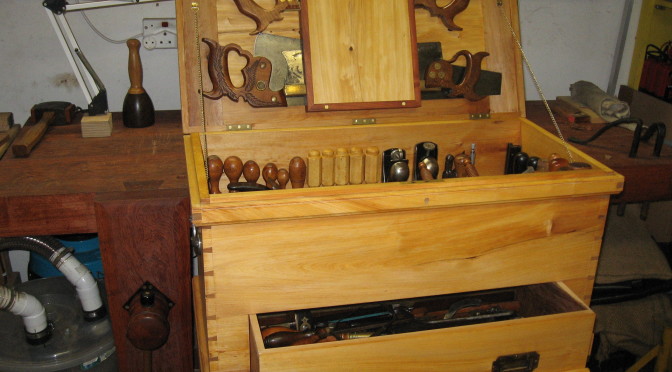



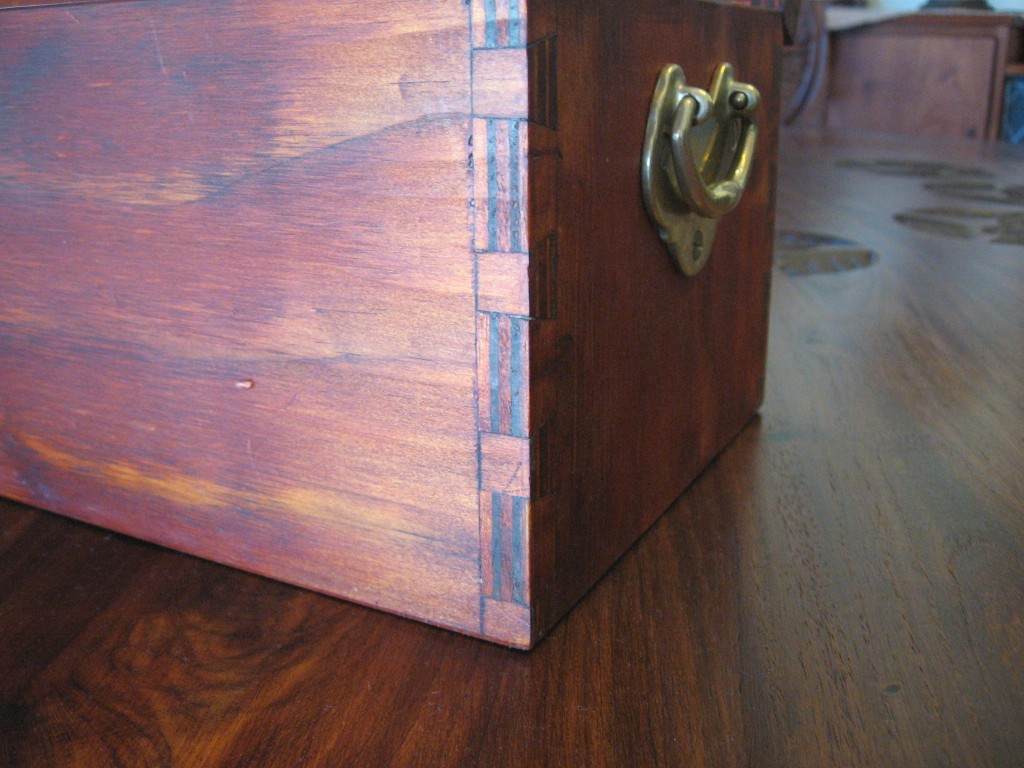

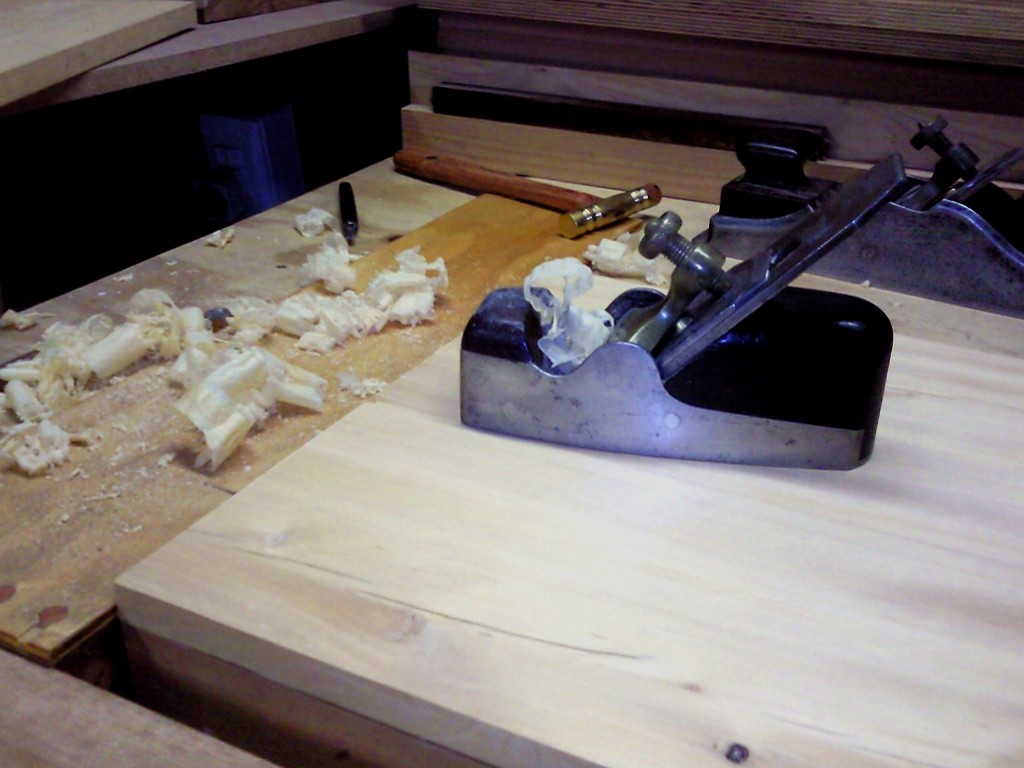



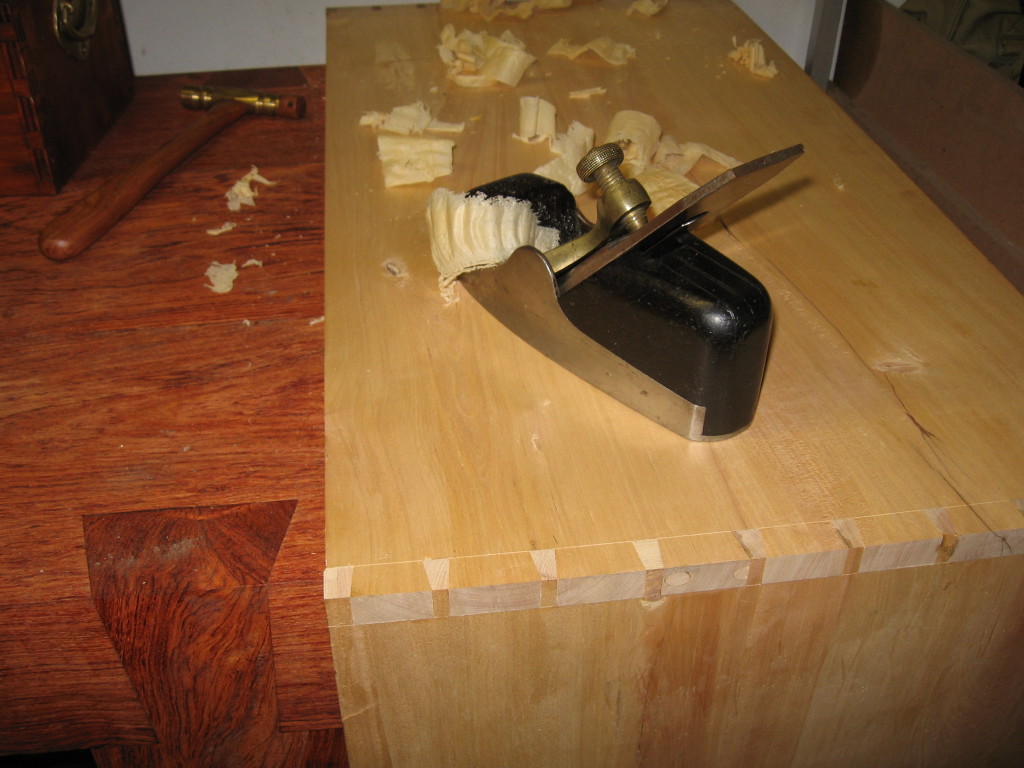
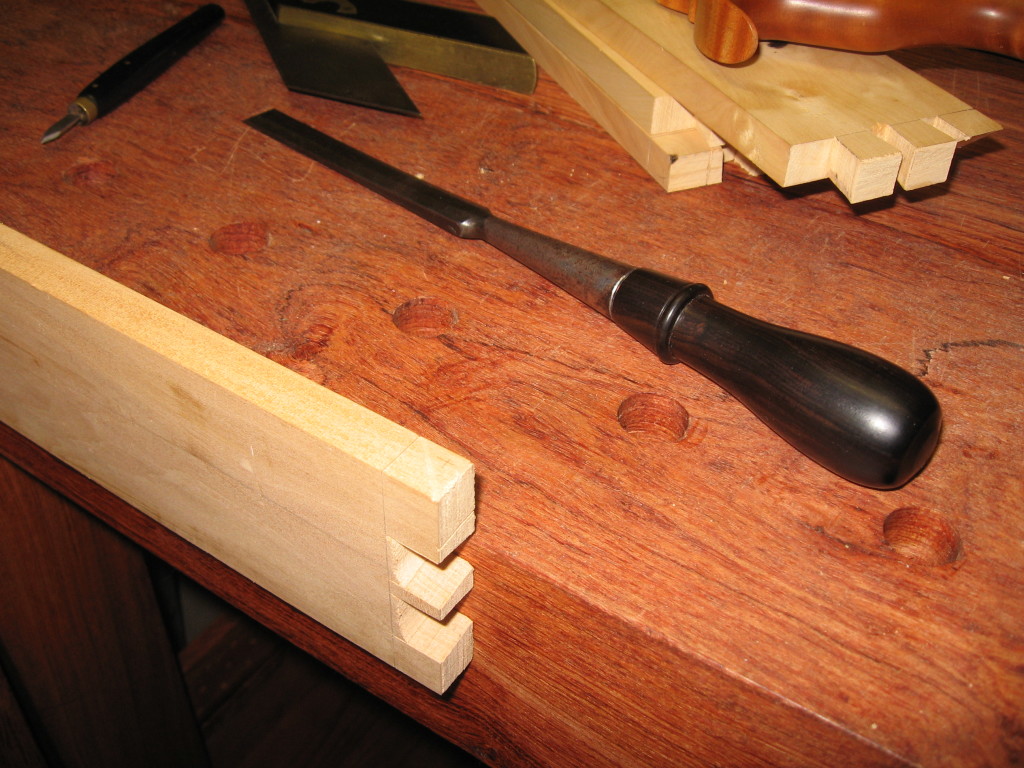


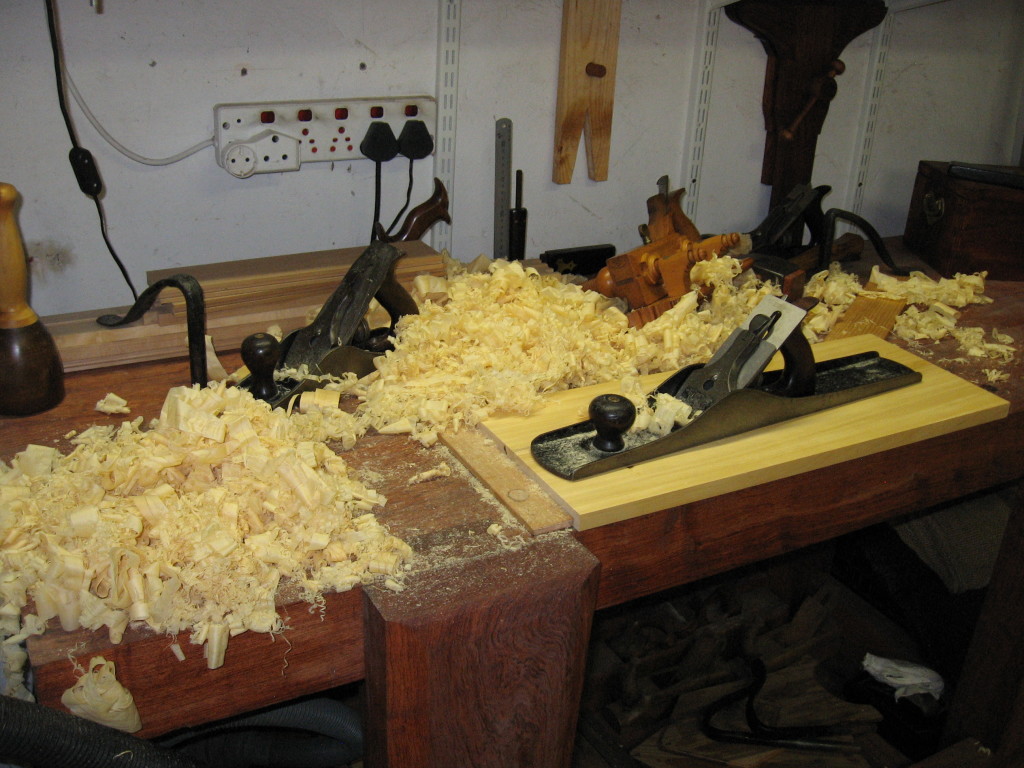
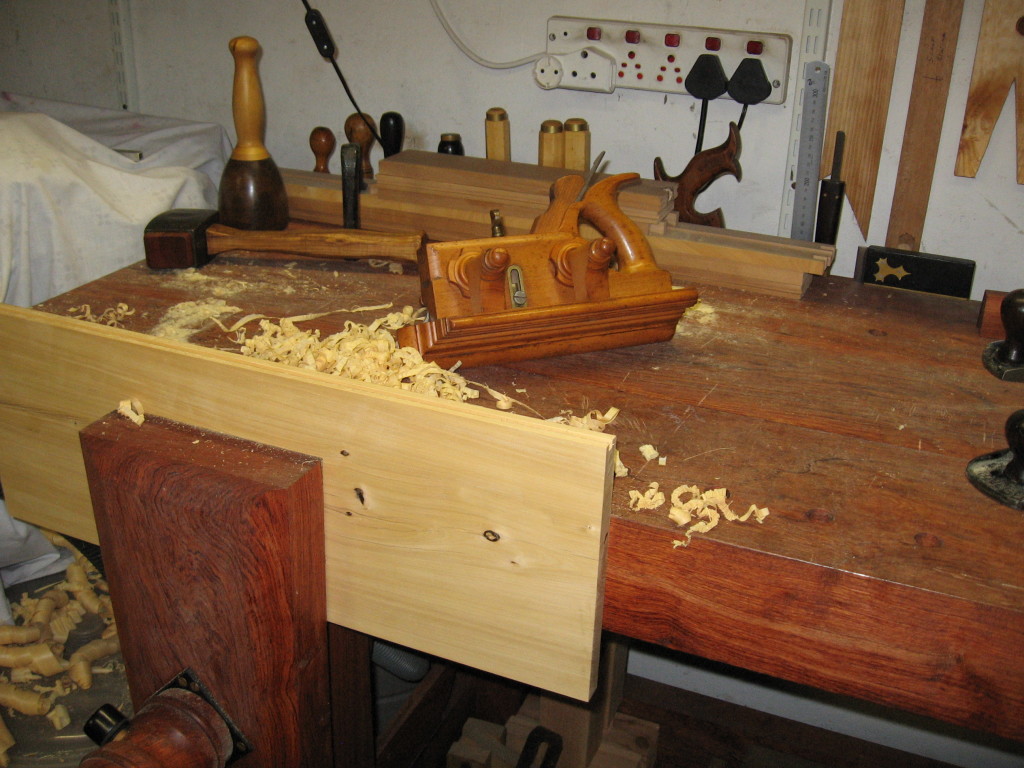
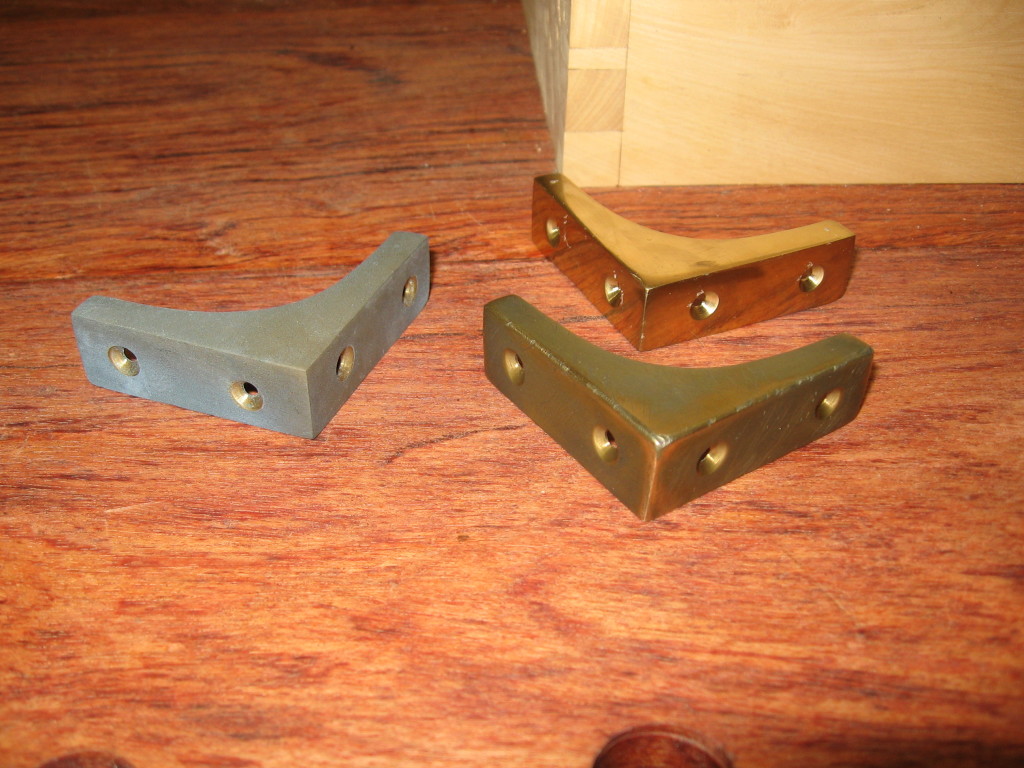

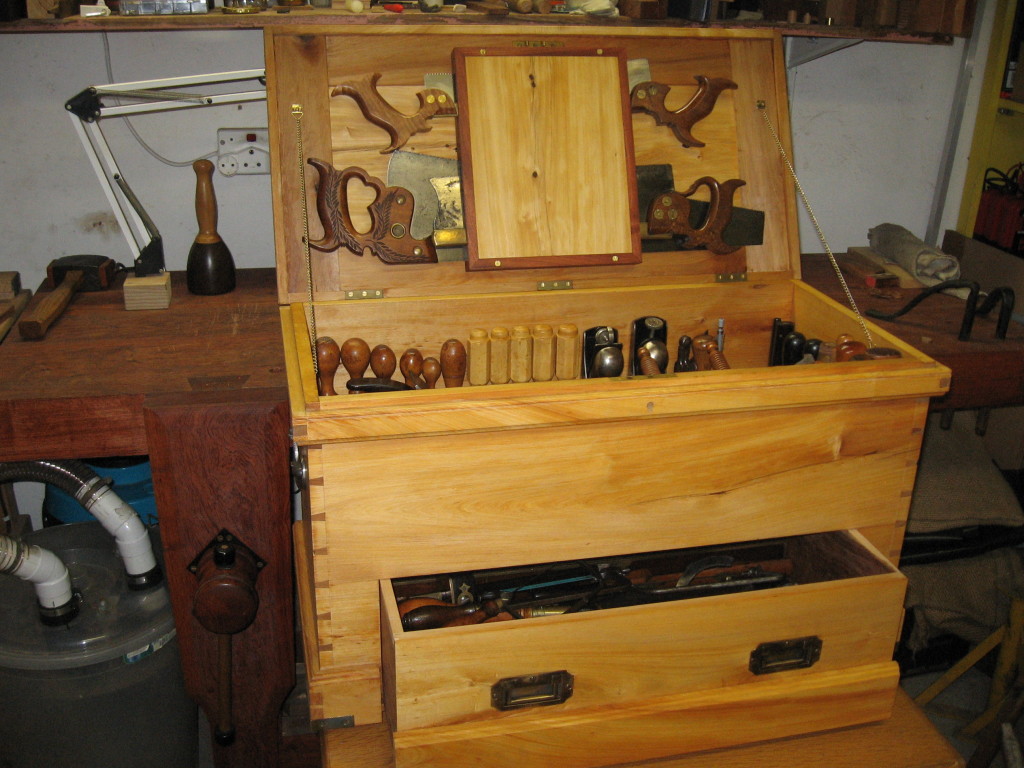
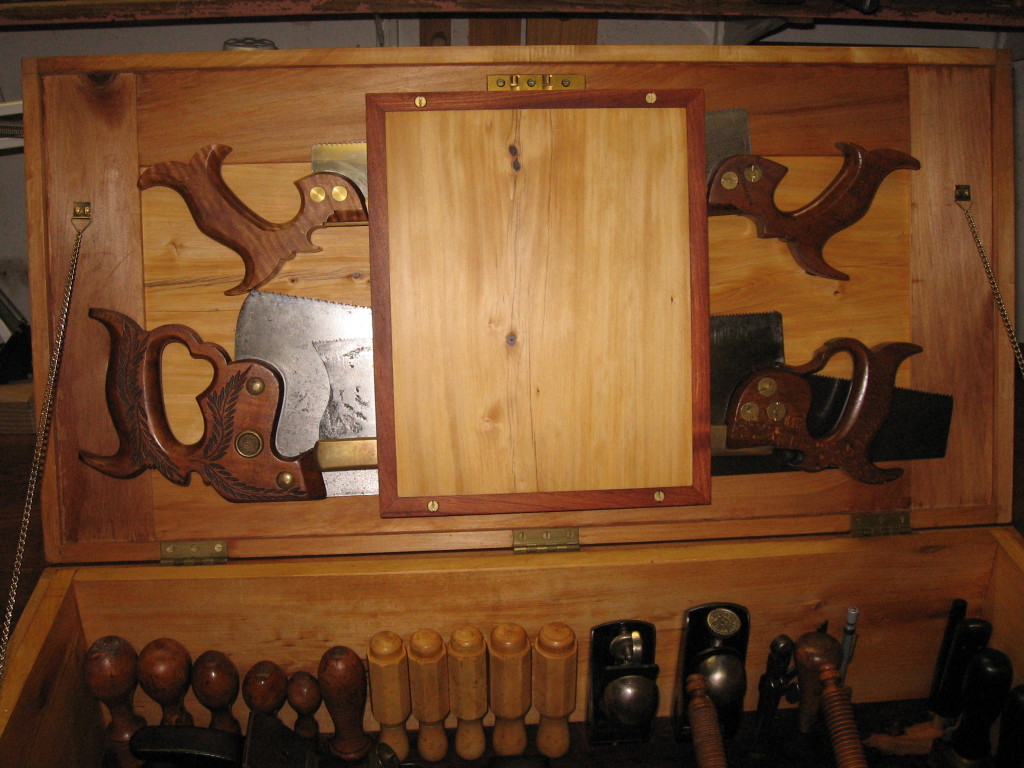
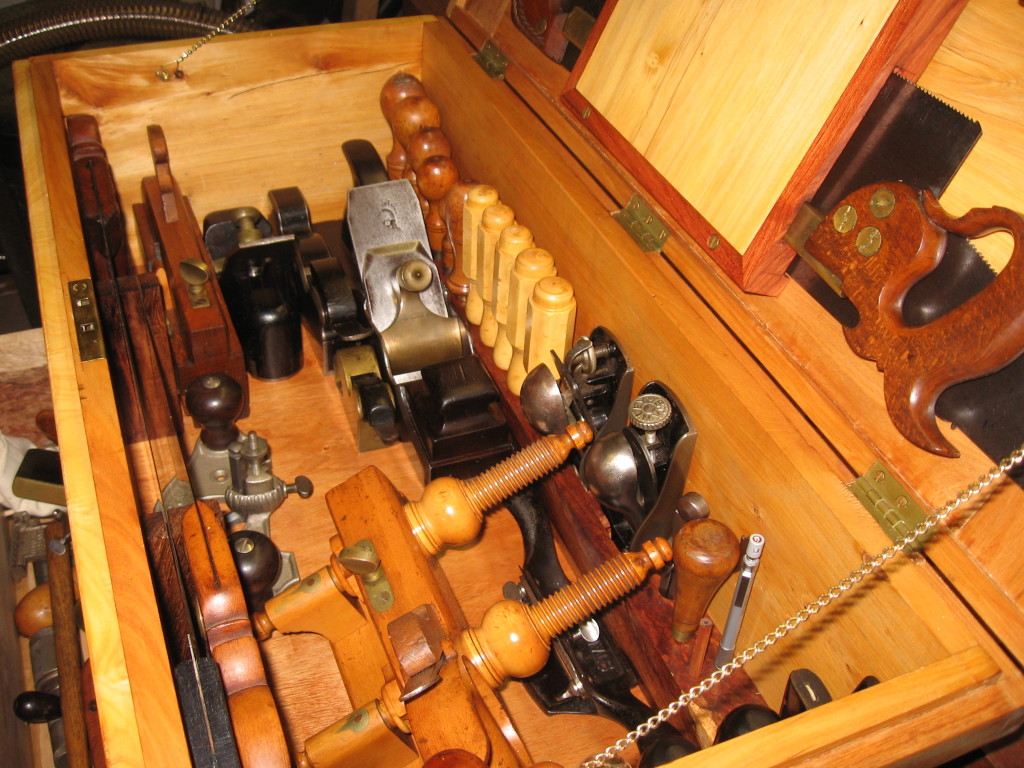
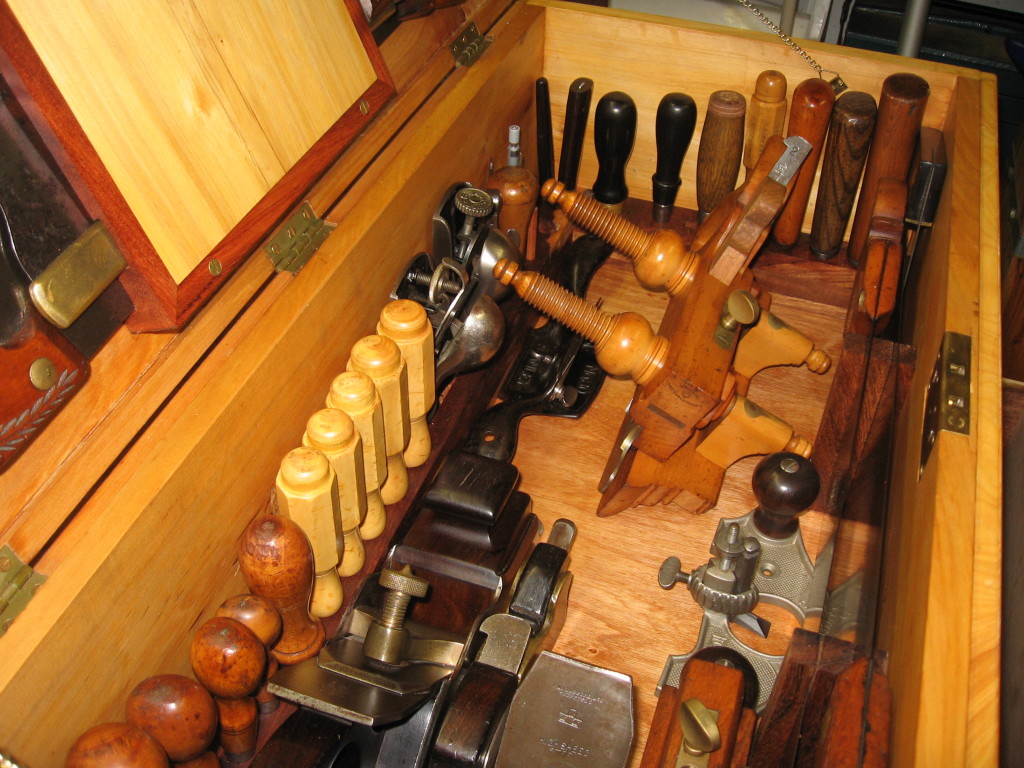
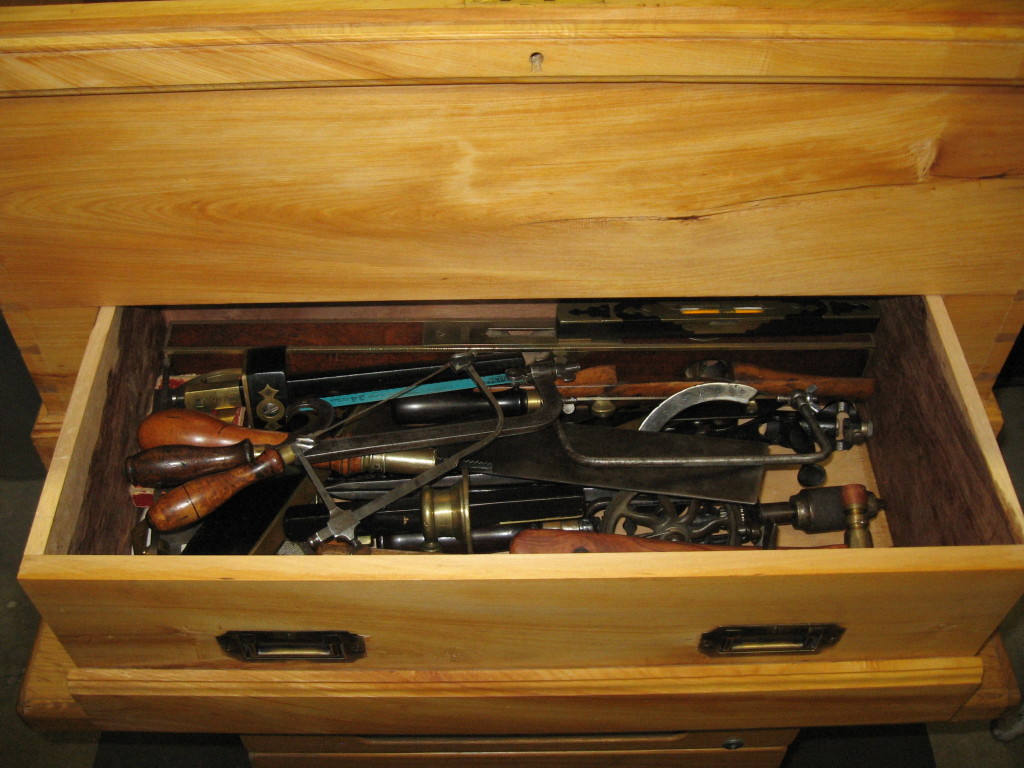
Nice job Frank and the contents of your chest is drool worthy 🙂
Perhaps a post on the tools inside?? Im sure many of us Galoots would love that.
Reference your drawers insides, lined with felt or cork.
I would advise cork instead of felt, especially in your climate. I’Il be worry about the felt absorbing and keeping humidity and promoting rust.
I see that like Gerhard you have fancy taste when it comes to tools 🙂
Keep up the good work.
Bob, impressed
Thanks Bob. Yes, I’m thinking of writing something on the tools, especially on the ones’ I restored and which handles I had to replace. Just for you guys to see the type of (African) timber that we use this side of the pond.
Your remark on the lining is a very valid point, thank you for that. One sometimes feel inclined to cover these fantastic tools in velvet, but then, these are mere tools, supposed to be used and a dent here and there is normal. Cork it will be!
On the subject of “dent”, I think I have a few difficult years in front of me, with my son being drawn more and more to woodworking. You know, I sort of like my antique tools’ full sized horns, planes without cracked mouths or beds, saws without kinks………
I figure I’ll just have to cross that bridge when I get there and try my best to be just a normal loving, accommodating dad because it should be a precious time together. This is after all an opportunity to introduce a loved one to traditional woodworking! And I’ll try not be an obsessive ToolGaloot.
Cape greetings
Frank
You are welcome Frank.
Yes by all means spend some time with your son woodworking, it will create long lasting memories for both of you and your tools would be appreciated long after we are both gone.
I understand your concerns, you have some serious tools in there.
Simple solution is to make your son his own tools kit. That’s what my dad did for me many moons ago, and as my own kids were growing up and misplacing my tools, suddenly I realized why he did that 🙂
Bob, looking forward to your next one
Those are the key here, Bob, creating lasting memories!
Though I’m definitely not a perfectionist, I can go into my shop with my eyes closed and put my hand on any tool in my shop that I want to. So, when you mention “misplaced tools”……
Bit in two minds regarding the son’s set. To be honest, I am (halfheartedly) in the process of compiling a second set of tools. Disston D-12 instead of my #12, WW2 era jack instead of my Type 11, gave him my vintage (1990’s) octagonal Sorby chisel set instead of my Witherby’s etc etc.
Though I’m not wanting to do away with this second set just yet, I think he’ll appreciate it more one day, to have been working all his life with the same set as his dad had been working with?
Will see how this pans out. Perhaps the first (and last) time the Bedrock crashes into the floor, the second tool set appears out of nowhere… Eisch.
Cape greetings
Frank
Bob and Frank
I think this is another very interesting topic to explore further. My natural inclination was the same as Bob’s, to collect a second set of tools. In that sense I am the same as Frank in that I will have a heart attack if my tools get damaged, but I have not considered the angle of them possibly appreciating the heirlooms more if they have their own history with the tools. Maybe I should explore this a bit further in a post, as it must be a fairly universal issue for many woodworkers.
Thanks again for the wonderful inspiration that comes form both of your musings.
Gerhard
Frank
Yet another excellent post and project. I agree with Bob, maybe you should consider doing a post on the tools in this beautiful chest. Where I realised that you have quite superior knowledge of tools was when you and Bob saw the company logo stamped into the single bevel axe (and correctly identified the maker) on the foto I took, and I never even saw it while restoring the tool. For those of you who are interested in this story, look under Recent Reverie and click on Swedish side axe.
Therefore I think you can probably teach us all something new by elaborating on the history behind the se precious tools.
Bob I am not sure whether Frank and I should take that as a compliment.
Cheers
Gerhard
Appreciate the opportunity, Gerhard, thanks man!
I’ll speak to you re the next posts and how you think we should be structuring them to be still enjoyable to readers.
Regards
Frank
Huhhh??? Now I am the one who not sure what you meant by if you should taking it as a compliment??
Bob scratching his forehead
No worries Bob
Probably lost in translation. Sometimes people from the an Afrikaans background feel uncomfortable with having nice stuff, like a type of guilt or something. Then again some others are incredibly materialistic, so the usual confusion we have with where we want to be in this world. You might need to read that Herman Charles Bosman stories, I was on about recently to get a better idea. Let’s just say I have good taste in tools.
Hope that helps, nothing to worry about. Maybe Frank has a more elegant explanation.
Cheers my friend
Gerhard
Nah, no help from me! Have no idea why I have developed such an affinity for old tools. May have to make an appointment with someone to look into my head – you available for a session, Gerhard???
When I see an old rusty and neglected tool (of promising quality) being sold somewhere, I feel an urge to buy it, restore it, just so that someone can experience the quality and craftsmanship of these old tools (please note I hate kinked saw plates…). These tools are not imitations, they’re real! Not necessarily fancy or ornate stuff, just great quality old tools.
And then I’ve developed a liking for certain makers’ tools. For instance, personally I’d prefer a Spiers smoother to a Norris, which is of course the more collectible plane. Its good to listen to other woodworkers/collectors’ opinion, but ultimately you have to make your own choice (and pay for it). That said, while I have a preference for Spiers, I ended up with a Mathieson smoother, with which I’m totally fine with. Dovetailed sole, Rosewood buns, fantastic craftsmanship, no cracks, antique, what more can you ask for?
Gerhard, perhaps all of us should later on submit a 500 word essay on what drives us to collect tools, our criteria etc and then have an open discussion, or something in that vein. But much later on….
Regards
Frank
I think that is a very good idea Frank. Maybe we should give everyone some time to mull over this issue (of why we collect tools) for a while and then launch a campaign.
Regards
Gerhard
Frank,
Thanks for sharing anther great post. The chest is beautifully done, and what a set of tools. That plough and those infills… Very cool.
All the best,
Jonathan
Much appreciated Jonathan! With me, taking my time building it and savoring every moment (I usually had time for it, and when I didn’t have the time, I just set it aside for another day), it took ages to finish.
Regards
Frank